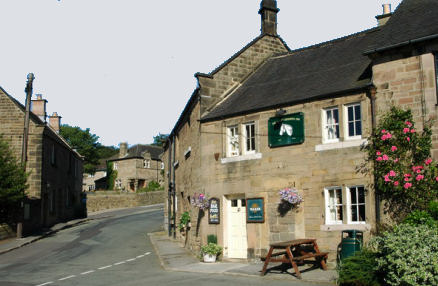Stanton in the Peak
OS Grid ref:-
 The pretty gritstone village of Stanton in Peak is situated around a mile away to the north of Birchover and seven miles north-west of Matlock in the White Peak. The village is an ancient settlement, having been granted a Royal Charter in 968.
The pretty gritstone village of Stanton in Peak is situated around a mile away to the north of Birchover and seven miles north-west of Matlock in the White Peak. The village is an ancient settlement, having been granted a Royal Charter in 968.
Stanton Hall, hides behind a high wall along the village street, it dates from the late sixteenth century and is the home of the Thornhill family. The hall was rebuilt in 1693, and further over a century later by Bache Thornhill, today only a gabled bay remains of the original building.
The village church, Holy Trinity, with its perpendicular spire, was built by William Pole Thornhill in 1839 and stands almost adjacent to the hall. Inside there is a bronze Italian water stoup from the workshop of Bellini.
There are many fine stone houses, with mullion windows, most of which date from the seventeenth and eighteenth centuries. Holly House, (pictured right) which faces the main street, dates back to the fifteenth century, a three-storey building, 2 of its 14 windows are blocked up, a result of the window tax in 1697. Opposite stands the village pub which bears the strange sounding name of Flying Childers. It was named after a famous eighteenth century racehorse owned by the fourth Duke of Devonshire and trained by Sir Hugh Childers.
 The reading room, which now serves as the village hall, was built by the Thornhill family, as was the ‘The Stand’. Originally known as ‘The Belvedere’, it consists of a viewing platform with a stone seat, which provides superb panoramic views over the Wye Valley.
The reading room, which now serves as the village hall, was built by the Thornhill family, as was the ‘The Stand’. Originally known as ‘The Belvedere’, it consists of a viewing platform with a stone seat, which provides superb panoramic views over the Wye Valley.
To the east of the village lies Stanton Moor, which consists of a plateau which rises to 280-320 metres above sea level. Famed for its many prehistoric sites, the wild upland area was an important site in the Bronze Age.
There are four stone circles, dating from the Bronze Age and at least 70 barrows on the moor. The most famous of these is the Nine Ladies Stone Circle., with the King`s Stone close by. The moor has long been considered as a sacred place for the ancient Celtic priests, the Druids, and many of the `menhirs' or monoliths are believed to have sacred significance and to be associated with Druid worship. Near the northern edge of the moor stands the square Earl Grey Tower built by the Thornhill family to commemorate the passing of the Reform Bill of 1832.
Nearby places of interest
Lea Gardens are situated near the town of Matlock. The garden nestles in a south west facing slope at an height of 700 feet above sea level on the northern edge of the Amber Valley, with scenic views of the Peak District hills beyond.
Lumsdale Valley, above the town of Matlock, is a thickly wooded gorge of outstanding natural beauty and a very interesting history, with stone ruins, waterwheels, ponds and waterfalls.
Chatsworth House known as "The Palace of the Peak" is the country seat of the Duke of Devonshire and is situated on the banks of the River Derwent, 3.5 miles to the northeast of Bakewell in the heart of the Peak District National Park.
Dovedale a dramatic limestone ravine, with its impressive rock outcrops and tranquil woodlands is arguably the prettiest and most famous of the dales in the Peak District National Park.
